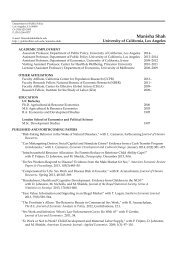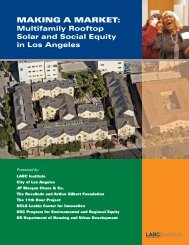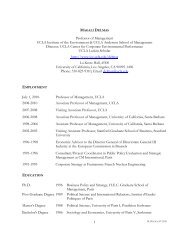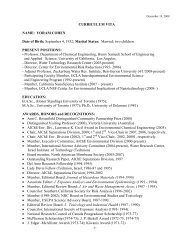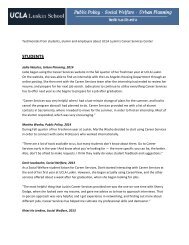Director's Report 2011.pdf - UCLA Luskin School of Public Affairs
Director's Report 2011.pdf - UCLA Luskin School of Public Affairs
Director's Report 2011.pdf - UCLA Luskin School of Public Affairs
You also want an ePaper? Increase the reach of your titles
YUMPU automatically turns print PDFs into web optimized ePapers that Google loves.
Green Chemistry for a Healthier California<br />
“The <strong>Luskin</strong> Center is providing<br />
critical support to allow us<br />
to translate scientific research<br />
into tangible and validated guidance<br />
that will be <strong>of</strong> direct use to a<br />
broad range <strong>of</strong> stakeholders.”<br />
— Hilary Godwin<br />
Nanomaterials have the potential<br />
to provide radically new approaches to challenges<br />
such as producing cheap solar energy or<br />
removing contaminants from water. However,<br />
the rosy future <strong>of</strong> nanotechnology is clouded<br />
by uncertainty concerning the possible risks<br />
<strong>of</strong> nanomaterials to human health and the<br />
environment. Questions remain about the best<br />
practices for safe handling <strong>of</strong> nanomaterials.<br />
A key objective <strong>of</strong> the <strong>Luskin</strong> Center’s Green<br />
Chemistry initiative is to present a path for<br />
moving forward in this climate <strong>of</strong> uncertainty<br />
and to provide guidance for capitalizing on the<br />
opportunities <strong>of</strong> nanotechnology without compromising<br />
the health and safety <strong>of</strong> employees,<br />
the public, and future generations.<br />
The initiative is advancing health and environmental<br />
protections in the field <strong>of</strong> engineered<br />
nanomaterials (ENMs). In collaboration<br />
with academic partners and state and federal<br />
agencies, researchers on this initiative investigate<br />
the possible risks to human health and the<br />
environment posed by the booming nanotechnology<br />
industry.<br />
The current project will result in a user<br />
manual <strong>of</strong> best practices designed to protect<br />
workers and the public. The initiative will<br />
1) provide an up-to-date understanding <strong>of</strong> how<br />
industry is currently managing its workplace<br />
and environmental concerns regarding ENMs<br />
and best practices in doing so, 2) provide a critical<br />
analysis <strong>of</strong> guidance documents in light <strong>of</strong><br />
current toxicological assessments, and<br />
3) provide an understanding <strong>of</strong> the investment<br />
needed to adopt recommended policies.<br />
Hilary Godwin, <strong>Luskin</strong> scholar and pr<strong>of</strong>essor<br />
in the <strong>School</strong> <strong>of</strong> <strong>Public</strong> Health, directs the initiative.<br />
The initiative depends on interdisciplinary<br />
collaborations, with Khadeeja Abdullah, MPH,<br />
a doctoral student in the environmental science<br />
and engineering program at <strong>UCLA</strong>, coordinating<br />
the effort. Civic partners include the California<br />
Department <strong>of</strong> Toxic Substance Control, the<br />
National Institute <strong>of</strong> Occupational Safety and<br />
Health, and other academic institutions.<br />
“The <strong>Luskin</strong> Center is providing critical support<br />
to allow us to translate scientific research<br />
into tangible and validated guidance that will<br />
be <strong>of</strong> direct use to a broad range <strong>of</strong> stakeholders,”<br />
states Godwin.<br />
www.luskin.ucla.edu<br />
Initiatives<br />
13



